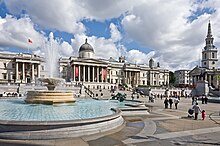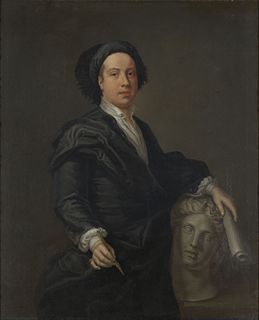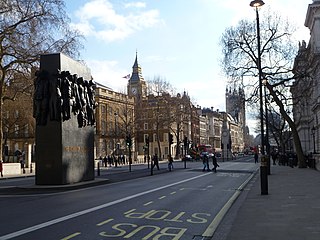





The City of Westminster contains many of the most famous tourist sites in London.






The City of Westminster contains many of the most famous tourist sites in London.

Buckingham Palace is a London royal residence and the administrative headquarters of the monarch of the United Kingdom. Located in the City of Westminster, the palace is often at the centre of state occasions and royal hospitality. It has been a focal point for the British people at times of national rejoicing and mourning.

The Palace of Westminster serves as the meeting place for both the House of Commons and the House of Lords, the two houses of the Parliament of the United Kingdom. Informally known as the Houses of Parliament, the Palace lies on the north bank of the River Thames in the City of Westminster, in central London, England.

William Kent was an English architect, landscape architect, painter and furniture designer of the early 18th century. He began his career as a painter, and became Principal Painter in Ordinary or court painter, but his real talent was for design in various media.

Edward Hodges Baily was a prolific English sculptor reponsable for numerous public monuments, portrait busts, statues and exhibition pieces as well as works in silver. He carved friezes for both the Marble Arch and Buckingham Palace in London. His numerous statues of public figures include that of Horatio Nelson on top of Nelson's Column and Charles Grey, 2nd Earl Grey on Grey's Monument in Newcastle upon Tyne. Throughout his career Baily was responsible for creating a number of monuments and memorials for British churches and cathedrals, including several in St Paul's Cathedral.

Sir Charles BarryFRS RA was a British architect, best known for his role in the rebuilding of the Palace of Westminster in London during the mid-19th century, but also responsible for numerous other buildings and gardens. He is known for his major contribution to the use of Italianate architecture in Britain, especially the use of the Palazzo as basis for the design of country houses, city mansions and public buildings. He also developed the Italian Renaissance garden style for the many gardens he designed around country houses.

Sir William Chambers was a Swedish-Scottish architect, based in London. Among his best-known works are Somerset House, and the pagoda at Kew. Chambers was a founder member of the Royal Academy.

Whitehall is a road and area in the City of Westminster, Central London. The road forms the first part of the A3212 road from Trafalgar Square to Chelsea. It is the main thoroughfare running south from Trafalgar Square towards Parliament Square. The street is recognised as the centre of the Government of the United Kingdom and is lined with numerous departments and ministries, including the Ministry of Defence, Horse Guards and the Cabinet Office. Consequently, the name "Whitehall" is used as a metonym for the British civil service and government, and as the geographic name for the surrounding area.

The Palace of Whitehall at Westminster was the main residence of the English monarchs from 1530 until 1698, when most of its structures, except notably Inigo Jones's Banqueting House of 1622, were destroyed by fire. Henry VIII moved the royal residence to White Hall after the old royal apartments at the nearby Palace of Westminster were themselves destroyed by fire. Although the Whitehall palace does not survive, the area where it was located is still called Whitehall and has remained a centre of government.

James Wyatt was an English architect, a rival of Robert Adam in the neoclassical and neo-Gothic styles. He was elected to the Royal Academy in 1785 and was its president from 1805 to 1806.

William Calder Marshall ARSA was a Scottish sculptor.

The culture of London concerns the music, museums, festivals and lifestyle within London, the capital city of the United Kingdom. London has frequently been described as a global cultural capital and is one of the world's leading business centres, renowned for its technological readiness and economic clout, as well as attracting the most foreign investment of any global city. As such, London has often been ranked as the world's capital city.

The Jubilee Walkway is an official walking route in London. It was originally opened as the Silver Jubilee Walkway to commemorate Queen Elizabeth II's accession; the Queen herself opened it on 9 June 1977 during her silver jubilee celebrations. The intention was to connect many of London's major tourist attractions and it is now one of seven such walks within the Mayor of London's strategic walking routes. Its length is 15 miles.

Edward Armitage was an English Victorian-era painter whose work focused on historical, classical and biblical subjects.

William Brodie was a Scottish sculptor, working in Edinburgh in the 19th century.

New Palace Yard is a yard northwest of the Palace of Westminster in Westminster, London, England. It is part of the grounds not open to the public. However, it can be viewed from the two adjoining streets, as a result of Edward Middleton Barry, who also assisted with its landscaping, having used railings rather than walls or fencing in its design. The yard has existed since about the year 1100, but was greatly reduced in the 18th century to allow for the construction of new streets and buildings, the most notable of which is the wing taking up the eastern end and having the most prominent tower of the current palace. Speaker's Green fronts the Thames. An underground car park used by Members of Parliament is beneath. Before latest incarnations of the palace, the yard was an open public space used diversely such as for speeches, tournaments, pilloryings, and executions. It has twice been the scene of terrorist attacks.

Thomas Campbell was a Scottish sculptor in the early 19th century. He has several important public works, most notably a statue of Sarah Siddons in Westminster Abbey. He also has several works in the National Gallery in London. He was heavily patronised by the British aristocracy, as evidenced by his works.
The following outline is provided as an overview of and topical guide to London:
RIBA National Awards are part of an awards program operated by the Royal Institute of British Architects, also encompassing the Stirling Prize, the European Award and the International Award. The National Awards are given to buildings in the UK which are "recognised as significant contributions to architecture" which are chosen from the buildings to receive an RIBA Regional award.